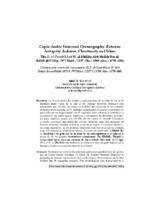Copto-Arabic Universal Chronography. Between Antiquity, Judaism, Christianity and Islam The K. al-Tawārīkh of N. al-Khilāfa Abū Shākir Ibn al-Rāhib (655 Heg. / 973 Mart. / 1257 Chr. / 1569 Alex. / 6750 AM)
Cronografía universal copto-árabe. El K. al-Tawārīkh de N. Abū Shākir Ibn al-Rāhib (655 H./973 Mart./1257 C./1569 Alex./6750 AM
Autor
Sidarus, Adel
Editor
Universidad de Córdoba, UCOPressFecha
2014Materia
HistoriografíaEdad Media
Árabe copto
Árabe cristiano
Intercambios culturales
Historiography
Middle Ages
Coptic Arabic
Christian Arabic
Cultural Interchanges
METS:
Mostrar el registro METSPREMIS:
Mostrar el registro PREMISMetadatos
Mostrar el registro completo del ítemResumen
La obra histórica del erudito y enciclopedista de la edad de oro de la literatura árabe copta, de la cual el Dr. Samuel Moawad (Munster) está preparando una edición, representa en realidad una colección de tres tratados divididos artificialmente en 51 capítulos secuenciales. El núcleo cronológico es precedido por un largo tratado con 47 capítulos sobre cálculos astronómicos y eclesiásticos así como épocas históricas y calendarios de diferentes naciones. La parte histórica propia (ch. 48-50), de los cuales el llamado Chronicon orientale representa una deficiente revisión anónima, trata sucesivamente de historia universal, dinastías islámicas y patriarcas coptos. Un sumario histórico, así como dogmático, de los primeros siete/ocho concilios de la Iglesia cristiana (cap. 51) termina la compilación entera. El conocido historiador al-Makin Ibn al-.Amid hace un gran uso de la labor de su contemporáneo y, al parecer a través de él, los grandes historiadores musulmanes: Ibn Khaldun, Maqrizi o Qalqashandi hacen mención continua de Ibn al-Rahib. Más tarde en el siglo XVI, el K. al-Tawarikh fue traducido en etiópico y tuvo un gran impacto en la literatura histórica y computacional de los etíopes. The historical work by the polymath and encyclopaedist from the golden age of Coptic Arabic literature, of which Dr. Samuel Moawad (Munster) is preparing an edition, represents in fact a collection of three treatises artificially divided into 51 sequential chapters. The chronological core is preceded by a long treatise of 47 chapters on astronomical and ecclesiastical reckoning and the historical eras and calendars of different nations. The historical part itself (ch. 48-50), of which the so-called Chronicon orientale is but a reworking, deals successively with universal history, Islamic dynasties and the Coptic Patriarchs. A survey of the first seven/eight Church Councils (ch. 51) ends the entire compilation. The well known historian al-Makīn Ibn al-‛Amīd makes large use of his contemporary’s work and, apparently through him, the great Muslim historians Ibn Khaldūn, Maqrīzī and Qalqashandī made constant mention of Ibn al-Rāhib. Later in the sixteenth century the K. al-Tawārīkh was translated into Ethiopian and had a significant impact on the historical and computational literature of the Ethiopians.
Palabras clave: Historiografía. Edad Media.

